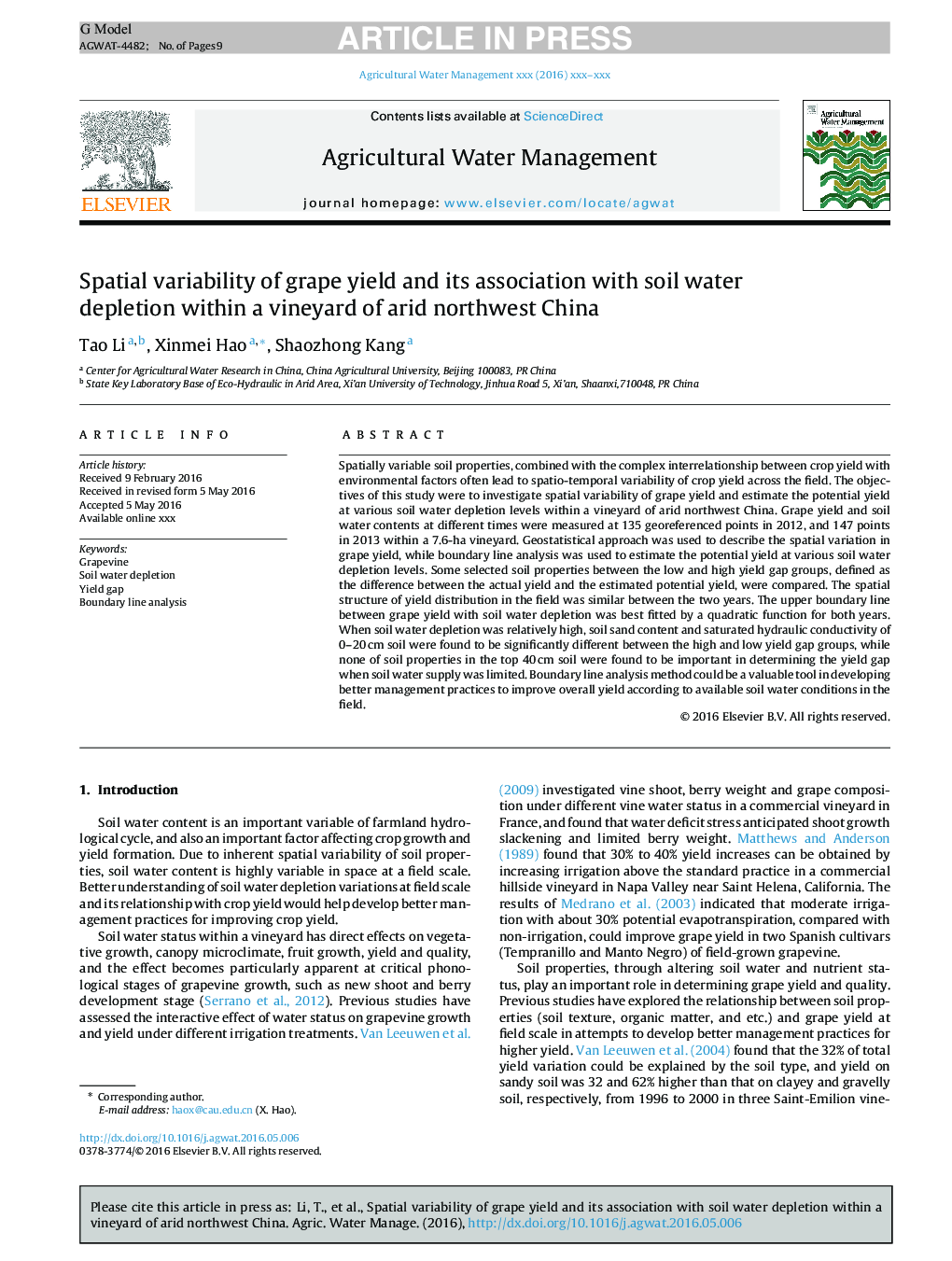| کد مقاله | کد نشریه | سال انتشار | مقاله انگلیسی | نسخه تمام متن |
|---|---|---|---|---|
| 5758600 | 1622901 | 2017 | 9 صفحه PDF | دانلود رایگان |
عنوان انگلیسی مقاله ISI
Spatial variability of grape yield and its association with soil water depletion within a vineyard of arid northwest China
ترجمه فارسی عنوان
تنوع فضایی عملکرد انگور و ارتباط آن با کاهش آب خاک در یک وحشگاه خشکی شمال غربی چین
دانلود مقاله + سفارش ترجمه
دانلود مقاله ISI انگلیسی
رایگان برای ایرانیان
کلمات کلیدی
انگور، تخلیه آب خاک، شکاف تولید، تجزیه و تحلیل خط مرزی،
ترجمه چکیده
خواص مکانیکی متغیر خاک، همراه با پیچیدگی پیچیدگی عملکرد محصول با عوامل محیطی، اغلب منجر به تغییر فضایی-زمانی از عملکرد محصول در حوزه می شود. هدف از این مطالعه، بررسی تنوع فضایی عملکرد انگور و ارزیابی عملکرد بالقوه در سطوح مختلف تخلیه آب خیز در یک تاکستان خشکی شمال غربی چین است. عملکرد انگور و محتوای آب خالص در زمان های مختلف در 135 نقطه جی پی اس در سال 2012 و 147 امتیاز در سال 2013 در یک مزرعه 7.6 هکتار اندازه گیری شد. برای توصیف تنوع فضایی در عملکرد انگور، از روش موقعیت جغرافیایی استفاده شده است، در حالیکه تجزیه و تحلیل خط مرزی برای ارزیابی عملکرد بالقوه در سطوح مختلف تخلیه آب خاک استفاده می شود. بعضی از خواص خاک انتخابی بین گروه های کوچک و کوتاه تولید شده که به عنوان تفاوت بین عملکرد واقعی و تولید بالقوه تخمین زده شده مقایسه شده است. ساختار فضایی توزیع عملکرد در این زمینه بین دو سال مشابه بود. خط مرزی بالایی بین عملکرد انگور با تخلیه آب خالص بهترین عملکرد برای هر دو سال بود. زمانی که تخلیه آب خاک نسبتا بالا بود، مقدار خاک خاک و هدایت هیدرولیکی اشباع از 20-20 سانتی متر در خاک خاک، تفاوت معنیداری بین گروه های کوچک و متوسط کاهش یافت، در حالی که هیچکدام از ویژگی های خاک در 40 درجه سانتی گراد خاک در تعیین تعادل عملکرد در هنگام تامین آب خاک محدودیت یافت. روش تجزیه و تحلیل خطی مرزی می تواند ابزار ارزشمند در ایجاد شیوه های مدیریت بهتر برای بهبود عملکرد کلی با توجه به شرایط آب موجود در زمین باشد.
موضوعات مرتبط
علوم زیستی و بیوفناوری
علوم کشاورزی و بیولوژیک
علوم زراعت و اصلاح نباتات
چکیده انگلیسی
Spatially variable soil properties, combined with the complex interrelationship between crop yield with environmental factors often lead to spatio-temporal variability of crop yield across the field. The objectives of this study were to investigate spatial variability of grape yield and estimate the potential yield at various soil water depletion levels within a vineyard of arid northwest China. Grape yield and soil water contents at different times were measured at 135 georeferenced points in 2012, and 147 points in 2013 within a 7.6-ha vineyard. Geostatistical approach was used to describe the spatial variation in grape yield, while boundary line analysis was used to estimate the potential yield at various soil water depletion levels. Some selected soil properties between the low and high yield gap groups, defined as the difference between the actual yield and the estimated potential yield, were compared. The spatial structure of yield distribution in the field was similar between the two years. The upper boundary line between grape yield with soil water depletion was best fitted by a quadratic function for both years. When soil water depletion was relatively high, soil sand content and saturated hydraulic conductivity of 0-20Â cm soil were found to be significantly different between the high and low yield gap groups, while none of soil properties in the top 40Â cm soil were found to be important in determining the yield gap when soil water supply was limited. Boundary line analysis method could be a valuable tool in developing better management practices to improve overall yield according to available soil water conditions in the field.
ناشر
Database: Elsevier - ScienceDirect (ساینس دایرکت)
Journal: Agricultural Water Management - Volume 179, 1 January 2017, Pages 158-166
Journal: Agricultural Water Management - Volume 179, 1 January 2017, Pages 158-166
نویسندگان
Tao Li, Xinmei Hao, Shaozhong Kang,
